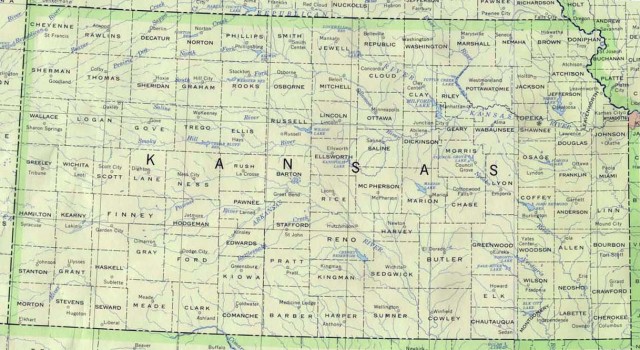The State of Kansas
AT A GLANCE
Name: Kansas is from a Sioux word meaning “people of the south wind.”
Nickname: Sunflower State, Jayhawker State
Capital: Topeka
Size: 82,282 sq. mi. (213,110 sq km)
Population: 2,911,641 (2015 est)
Statehood: Kansas became the 34th state on January 29, 1861.
Electoral votes: 6 (2016)
U.S. Representatives: 4 (until 2016)
State tree: cottonwood
State flower: native sunflower
State animal: American buffalo
Highest point: Mount Sunflower, 4,039 ft. (1,231 m)

THE PLACE
Kansas is made up of both level and rolling plains, which increase in height in the western part of the state. The western portion, which is part of the Great Plains, is the driest region in Kansas. The southeastern part of the state is generally flat land that is valuable for grazing cattle.
The northeastern region, which is also level, was covered by glaciers during the last Ice Age. These glaciers left behind rich deposits of soil that have since been cut and crisscrossed by rivers. Many different kinds of trees grow in the river valleys.
Kansas's climate is much more variable than its land. The state experiences cold, snowy winters and hot summers. During the winter, cold air from the north chills the state, while hot winds from the south bring intense heat during the summer.
From day to day the weather can change rapidly, and residents of Kansas often have to protect themselves from blizzards and hail in winter and powerful thunderstorms and tornadoes in summer.
Facts and Firsts
- The geographical center of the contiguous United States lies in Smith County.
- Dodge City is the windiest city in the United States.
- Kansas has North America's largest population of wild grouse, commonly known as prairie chickens.
- In 1909, William Purvis and Charles Wilson of Goodland invented the helicopter.
- The international fast food chain Pizza Hut began in Wichita.
THE PAST
Before Kansas became heavily settled, large herds of buffalo roamed its prairies. These buffalo provided food for a number of Native American tribes, including the Kansa, Osage, Pawnee, and Wichita, who lived in the area.
The first Europeans to explore Kansas were the Spanish, who were searching for gold. The French later claimed most of present-day Kansas and sold it to the United States as part of the Louisiana Purchase in 1803.
Before Kansas became a state, however, it was caught in the national fight over slavery. During the 1850s, many people who wanted to build a railroad from the East to California began to push for former western territories to become official states. Congress had trouble deciding whether to admit Kansas as a free or slaveholding state, so it allowed residents of the Kansas territory to vote for themselves. Soon, people from all over the country began pouring in and casting votes, and the region became known as “Bloody Kansas” as settlers fought each other in violent skirmishes over their votes. After many slaveholding Southern states withdrew from the Union, Kansas was officially admitted into the Union as a state in 1861.
During the 1870s, railroads were built through Kansas and the era of the cattle towns began. Ranchers and cowboys from Texas drove their cattle north to Kansas to be shipped east by railroad. Legendary lawmen, including “Wild Bill” Hickok and Wyatt Earp, tried to keep order in the cattle towns of Dodge City and Wichita.
Cowboys clashed with farmers who wanted to build fences and grow corn and wheat. In the end the farmers won, and Kansas became the “breadbasket” of the United States, so-called because so much wheat for bread was grown there.
During World War II, the aviation industry began to produce airplanes and airplane parts in the city of Wichita. Other industries in Kansas expanded, and the state became increasingly urban.
During the 1980s, Kansas, like many other agricultural states, suffered from a number of economic problems. Prices for crops—especially wheat—fell, adversely affecting Kansas farmers. The state's economy improved by the end of the 1980s.
THE PRESENT
Kansas produces most of the nation's wheat, and its mills grind wheat into flour that is shipped all over the world. Kansas farmers also grow grain sorghum and hay for animal feed. Other major products include beef cattle and hogs.
Manufacturing is Kansas's most significant industry. Wichita is a center of the lightairplane industry, and more than 60 percent of the nation's aircraft is produced there. Food processing, to prepare many of the crops grown in Kansas to be sold around the world, is another major industry.
Born in Kansas
- Gwendolyn Brooks, poet
- Walter P. Chrysler, auto manufacturer
- John Steuart Curry, painter
- Robert Dole, U.S. senator
- Amelia Earhart, aviator
- William Inge, playwright
- Walter Johnson, baseball player
- Buster Keaton, comedian
- Stan Kenton, jazz musician
- Jim Lehrer, broadcast journalist
- Edgar Lee Masters, poet
- William Allen White, journalist